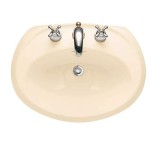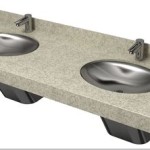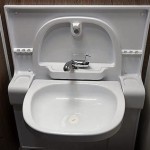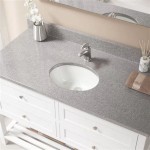Bathroom Sink Material Comparison: A Comprehensive Guide
Choosing the right material for a bathroom sink is a crucial decision, influencing both the aesthetic appeal and the long-term functionality of the space. A variety of materials are available, each offering unique characteristics in terms of durability, maintenance, style, and cost. This article provides a detailed comparison of common bathroom sink materials, enabling informed decision-making based on individual needs and preferences.
Porcelain/Vitreous China: The Timeless Classic
Porcelain, often referred to as vitreous china when glazed, is a widely used material for bathroom sinks. It is crafted from clay mixtures fired at high temperatures, resulting in a non-porous and durable surface. The glazing process creates a smooth, glossy finish that is resistant to stains and scratches, contributing to its ease of cleaning. Porcelain sinks are available in a wide range of shapes, sizes, and styles, making them suitable for diverse bathroom designs. Their affordability and widespread availability further contribute to their popularity.
One of the major advantages of porcelain is its resistance to heat and chemicals. This makes it well-suited for everyday use, even with harsh cleaning products. However, while relatively scratch-resistant, aggressive scrubbing with abrasive cleaners can dull the finish over time. While durable, porcelain is susceptible to chipping or cracking from heavy impact. Repairs are generally difficult and often require replacement of the entire sink.
The cost of porcelain sinks typically falls in the moderate range, making them an accessible option for many budgets. The installation process is relatively straightforward, especially for drop-in or pedestal sink models. The weight of porcelain can vary depending on the size and design, but generally, it is a manageable weight for most bathroom installations.
Ceramic: Versatility and Variety
Ceramic is a broad category encompassing various clay-based materials, including porcelain. However, ceramic sinks are generally less dense and more porous than their porcelain counterparts. This increased porosity makes them slightly more susceptible to staining and water absorption if not properly sealed and maintained. Despite this slight difference, ceramic sinks offer many of the same benefits as porcelain, including ease of cleaning and a wide range of design options.
Ceramic sinks are available in a vast array of colors, patterns, and textures, allowing for greater design flexibility. They can be manufactured in intricate shapes and styles, appealing to those seeking a more unique and personalized look. The versatility of ceramic extends to its installation options, as it can be used for various sink types, including undermount, vessel, and wall-mounted models.
The primary disadvantage of ceramic, compared to porcelain, is its slightly lower durability. While still a robust material, it is more prone to chipping and cracking under impact. Regular sealing may be necessary to maintain its stain resistance and prevent water damage. The cost of ceramic sinks can vary widely depending on the design, size, and manufacturer, but generally falls within a comparable range to porcelain.
Stone (Granite, Marble, Travertine): Natural Elegance and Luxury
Natural stone sinks, crafted from materials like granite, marble, and travertine, offer a sophisticated and luxurious aesthetic. Each stone exhibits unique veining and patterns, ensuring that no two sinks are exactly alike. These materials are known for their durability and resistance to heat, making them suitable for demanding bathroom environments. Stone sinks are typically more expensive than porcelain or ceramic options, reflecting their premium quality and natural beauty.
Granite is highly resistant to scratches and stains, making it a practical choice for high-traffic bathrooms. Marble, while offering a more refined and elegant appearance, is more porous and susceptible to staining, requiring regular sealing to maintain its pristine condition. Travertine, with its distinctive pitted texture, provides a rustic and earthy feel but also demands careful cleaning to prevent dirt and grime from accumulating in the crevices.
The weight of stone sinks is a significant consideration during installation. These sinks can be extremely heavy, requiring reinforced countertops and professional installation. Furthermore, the natural variations in stone can lead to inconsistencies in color and pattern, which should be carefully considered when selecting a sink. The porous nature of some stone types means that spills should be cleaned promptly to avoid permanent staining. The cost of stone sinks is typically the highest amongst the materials discussed, reflecting their inherent value and aesthetic appeal.
Solid Surface (Acrylic, Polyester): Seamless and Contemporary
Solid surface materials, such as acrylic and polyester resins, offer a seamless and contemporary look for bathroom sinks. These materials are engineered to be non-porous and resistant to stains and scratches, making them easy to clean and maintain. Solid surface sinks can be molded into various shapes and sizes, allowing for unique and custom designs. They are also available in a wide range of colors and finishes, catering to diverse aesthetic preferences.
One of the key advantages of solid surface sinks is their ability to be seamlessly integrated with countertops, creating a smooth and continuous surface. This eliminates the need for caulking and minimizes the risk of water damage. Solid surface materials are also repairable, allowing for the removal of scratches and stains with specialized cleaning products or professional polishing. While not as heat-resistant as stone or porcelain, solid surface sinks can withstand moderate temperatures without damage.
The cost of solid surface sinks generally falls in the mid-range, making them a cost-effective alternative to stone while offering a similar level of aesthetic appeal. The installation process is relatively straightforward, especially for undermount and integrated sink models. The lightweight nature of solid surface materials also simplifies the installation process. However, care should be taken to avoid harsh chemicals and abrasive cleaners, as they can dull the finish over time.
Metal (Stainless Steel, Copper): Modern Industrial or Rustic Charm
Metal sinks, particularly those made from stainless steel and copper, offer a distinctive and durable option for bathroom design. Stainless steel sinks provide a modern industrial aesthetic, while copper sinks exude a rustic and warm charm. Metal sinks are highly resistant to corrosion and staining, making them a practical choice for demanding bathroom environments.
Stainless steel sinks are known for their durability and hygienic properties. They are easy to clean and maintain, and their smooth surface prevents the growth of bacteria. Copper sinks possess antimicrobial properties, inhibiting the growth of microorganisms. Copper naturally develops a patina over time, adding to its unique character and visual appeal. Both stainless steel and copper sinks are relatively lightweight, simplifying the installation process.
One potential disadvantage of metal sinks is their susceptibility to water spots and fingerprints. Stainless steel sinks can also be prone to scratching, especially with abrasive cleaners. Copper sinks require regular polishing to maintain their shine and prevent excessive patina development. The cost of metal sinks can vary widely depending on the material, gauge (thickness), and design, but generally falls within the mid-range to high-end price point.
Glass: Transparency and Artistry
Glass sinks offer a unique and artistic element to bathroom design. Typically made from tempered glass for safety and durability, these sinks can be clear, frosted, colored, or textured, allowing for a wide range of aesthetic options. Glass sinks are non-porous and resistant to staining, making them relatively easy to clean and maintain. Their transparent nature allows light to pass through, creating a visually appealing effect.
One of the key advantages of glass sinks is their ability to complement various bathroom styles, from contemporary to traditional. They can be used as vessel sinks, undermount sinks, or integrated sinks, providing flexibility in design. Tempered glass is significantly stronger than regular glass and is designed to shatter into small, harmless pieces if broken. However, glass sinks are still more susceptible to chipping and cracking than other materials like porcelain or stone.
The primary disadvantage of glass sinks is their tendency to show water spots and fingerprints. Regular cleaning is necessary to maintain their pristine appearance. Also, the installation requires careful handling to avoid damage. The cost of glass sinks can vary widely depending on the design, thickness, and manufacturer. Intricate designs or hand-blown glass sinks can be significantly more expensive. Glass sinks exist on the higher end price point.
Concrete: Industrial Chic and Customization
Concrete sinks introduce an industrial chic aesthetic to bathroom spaces. Their raw, textured surface provides a unique and modern look. The ability to customize concrete sinks in terms of shape, size, and color allows for endless design possibilities. Concrete sinks are also known for their durability and heat resistance, making them suitable for demanding bathroom environments.
While concrete is inherently porous, concrete sinks are typically sealed with a protective coating to prevent water absorption and staining. Regular resealing may be necessary to maintain their water resistance. Concrete sinks can be heavy, requiring reinforced countertops and professional installation. The weight of concrete can also be a factor in transportation and handling. While highly durable, concrete can be susceptible to cracking under extreme stress or impact.
Maintaining a concrete sink requires understanding the nature of the material and using appropriate cleaning products. Acidic cleaners should be avoided, as they can damage the sealant and etch the concrete surface. A pH-neutral cleaner and a soft cloth are recommended for regular cleaning. The cost of concrete sinks can vary widely depending on the size, design, and customization options, with bespoke designs being more expensive. The price point exists within the mid to high range.
Key Considerations for Material Selection
Ultimately, the best bathroom sink material depends on individual priorities and preferences. By carefully considering the factors outlined above and weighing the pros and cons of each material, informed decisions can be made that enhance both the functionality and aesthetics of the bathroom space.
14 Best Kitchen Sink Materials For Ultimate Durability Style Vevano
14 Best Kitchen Sink Materials For Ultimate Durability Style Vevano
Bathroom Sink Material Guide Signature Hardware

Buy Classic Bathroom Vanity Designs Single Sink Fuao

Types Of Bathroom Sinks The Home Depot
Bathroom Sink Material Guide Signature Hardware

Common Sink Sizes How To Choose The Right Bathroom 2024

Types Of Bathroom Sinks The Home Depot

Best Bathroom Sink Material Types Of Materials
Bathroom Sink Material Guide Signature Hardware
Related Posts







